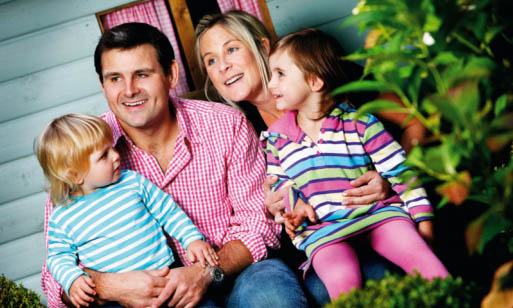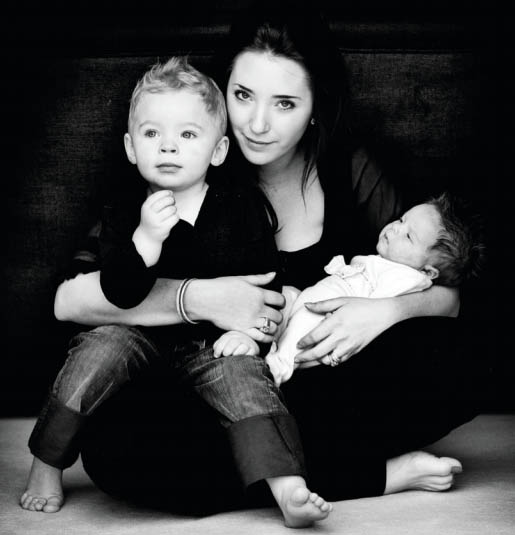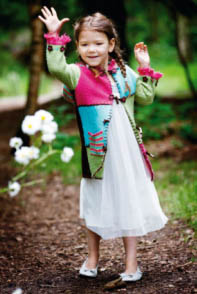
Find a clean background
Clean backgrounds, needless to say, are one of the key elements of a successful portrait. Some houses might have amazing wallpaper or conservatories that can work well in creating one, but if the decor’s a bit dodgy, try using the back of a sofa. This works particularly well when you’re taking photos of children. Simply drag a sofa near a doorway and turn it around. Sit your subjects in front of it so that you have a nice, solid block of colour, which is the sofa back behind them. Since the sofa is being illuminated by light reflected in from outside, the colour is going to be rich and warm. Even a black leather couch works nicely in this regard.
Under-expose for a clean background
Try switching off the lights in the hall. Ask the family to stand around three feet from the front door. Setting your camera’s metering mode to Spot and exposing for your subjects’ faces will under-expose the hall, helping to create a clean background.
Dress To complement The Season
Shooting outdoors, it may be difficult to find colourful backgrounds, particularly in winter. So on dreary days, ask subjects to wear something colourful or stripy to give the image some visual interest and warmth. Conversely, in summer, colour is just about everywhere, from golden light to verdant green or floral backdrops. To prevent your image being confused, with too many different shades in summer, ask your sitters to keep it simple with single colours and designs. Bringing along a change of clothes is always a good idea.

Make a day of it
It’s not enough to take your subjects into their garden or to the local park and take their photograph. A good portrait captures a genuine expression or an unguarded moment, and these typically come only when someone is having a great time and forgets about the camera. Instead, plan days out with all your subjects. Think about your shoots as an experience – a stroll through the woods, a picnic with family, a day at the beach – that everyone is sharing. People let their guard down, you get more natural pictures, and everyone feels as though they’ve had a fun day out. Rather than had their picture taken.
Give the room a more Spacious feel
If shooting indoors and the room feels cramped around your subject, try placing them in a corner and shooting from a low angle. This vantage point gives a greater emphasis to the lines where the ground meets the walls, which will travel from one key point out to the lower corners of your frame, giving the exaggerated appearance of open space. Using a wide-angle lens for this type of shot will enhance the effect even further.
Think about backgrounds again!
Rarely are you going to get a great shot without thinking of the background. A little planning goes a long way and while a clean background is one of the keys, planning and scouting your location can save you a lot of heart ache.

Choose the best aperture
Shooting outdoors is especially tough because there’s often a blanket of colour. If you shoot your subjects at f/8 aperture, they’re not going to be distinguished from the background. Use an aperture of about f/2.8 in your outdoor portraits so you can achieve minimum depth of field.
Control exposure
When you move from indoors to outdoors you’re ceding an element of control over the light. If it’s sunny and conditions are high-contrast, zooming into your subject will give you a more balanced exposure. A telephoto zoom, such as Brett’s trusty 70-200mm lens, is great for this purpose on outdoor shoots. The more scenery you wish to include in your background, the tougher it will be to get an even exposure because of all the ambient light you’re letting into your camera at wider focal lengths.
Make A Frame with Foliage
We’ve all used a canopy of leaves to produce a frame around a subject in our compositions, but you can take this technique to the extreme by getting down low and shooting from the ground up. Try using individual blades of grass, flowers and other ground foliage to frame people. The low vantage point gives the image dramatic emphasis, and the insect’s-eye view of the grass in the foreground creates an otherworldly appearance. When shooting indoors, you’ll likely want to use flash, particularly if your shot’s posed. If you set a wide aperture, a shutter speed of about 1/60 sec and bounce off-camera flash light from the ceiling or wall at your background (direct flash light will give you harsh results), you should be able to capture well-lit portraits at ISOs of 100 or 200.

Use Bounced Flash Indoors
When shooting indoors, you’ll likely want to use flash, particularly if your shot’s posed. If you set a wide aperture, a shutter speed of about 1/60 sec and bounce off-camera flash light from the ceiling or wall at your background (direct flash light will give you nasty results), you ought to be able to capture well-lit portraits at ISOs of 100 or 200.
No comments:
Post a Comment